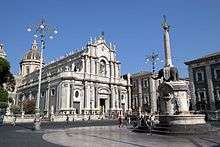Piazza del Duomo, Catania
The square

The Piazza del Duomo is the main square of the city of Catania. It takes its name from the Duomo di Catania or Cathedral of Saint Agatha which stands on the east side of the square. It was originally constructed in 1078-1093, on the ruins of the ancient Roman Achillean Baths. Access to the baths is by a short staircase left of the Cathedral. After an earthquake in 1693, Giovanni Battista Vaccarini designed a new Baroque façade in 1711.
Three streets enter the square: the via Etnea, the historical city axis; the via Giuseppe Garibaldi, and the via Vittorio Emanuele II that crosses it from east to west. On the eastern side of the square stands the Duomo, dedicated to Saint Agatha, patron saint of the city, whose feast is celebrated on 5 February.
On the north side is the palazzo degli Elefanti or the Town Hall. In front of this building stands a fountain designed by Vaccarini, consisting of an obelisk on the back of the elephant u Liotru, the (symbol of Catania).[1]
On the other side of the square, there is the Amenano fountain, in front of the Palazzo dei Chierici. Between the Palazzo dei Chierici and the Cathedral is the Porta Uzeda. From the terraces you can admire two splendid panoramas: on one side, the spectacle of Piazza del Duomo in Catania with the Elephant fountain and Via Etnea with Mount Etna in the background; on the other, the walls of Charles V, the port of Catania with the arches of the Marina up to the Ursino castle. The door of Charles V is part of the only remaining part of the city walls.
Access to the baths by accessing the Diocesan Museum of Catania: a barrel-vaulted corridor built into the gap between the Roman structures and the foundations of the cathedral (whose access consists of a short flight of steps at different times to the left of the façade) allows to take a trip into the bowels of the city, where the Amenano river flows, whose waters rise to the surface in the nearby Amenano fountain in the square in front. The name of the plant is deduced from an inscription on a marble slab of the Lunense area reduced to six very fragmented main fragments, probably dating back to the first half of the 5th century, now exhibited in the Civic Museum at Castello Ursino.
Festival celebrations
The Piazza del Duomo is a foal point for much of the celebrations related to the Festival of Saint Agatha, a three day event that takes place annually in early February. It begins on February 3 with a procession known as “della luminaria”, from the Church of St. Agata alla Fornace to the Cathedral of St. Agatha. This is followed in the evening by a concert in the Piazza del Duomo and fireworks.[2]